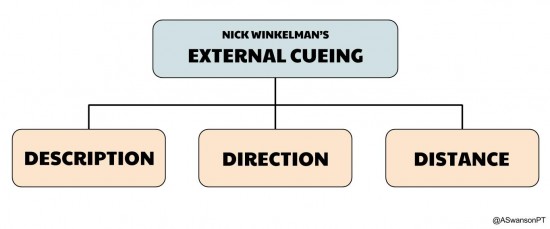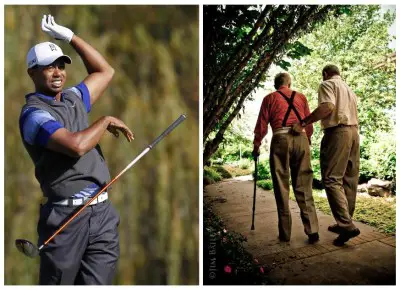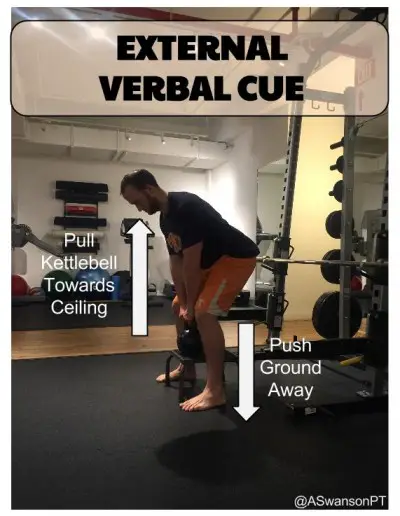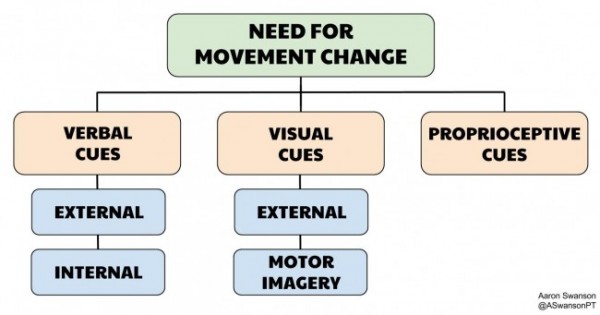The type of cue one chooses should be based on the environment, individual, and task.
This article should help you understand when to best choose an external cue.
External Cue: focuses on how the body’s output affects the environment (outcomes, objects, etc.)
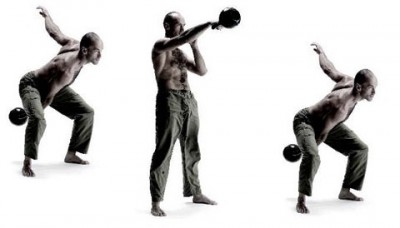
External Cue – “throw the kettlebell through the wall in front of you”
Science of External Cueing
External verbal cues (VC) have been the most commonly discussed type of cueing in the past decade. There’s a good reason: the latest research has provided some clear results that can have a major impact on coaching.
- “External focus allows the motor system to “self-organize”; efficiently coordinating and directing forces needed for accurate, maximal and sustained force production.” -David C. Marchant
Research shows:
External VC Are Better Than Internal VC for:
- Performance
- Skill Acquisition
- Complex Motor Tasks
- Multi-Segmental Motion
- Force Generation (summative, accuracy, endurance)
8 Benefits of External Cueing
- Allows the Motor System to “Self-Organize”
- Keeps Movement Reflexive and Automatic
- Frees the Brain From an Extra Task – Constrained Action Hypothesis
- Decreases Aberrant Muscle Activity = Less EMG Activity = Conservation of Energy
- Less Co-Contraction
- Increases Speed
- Better Retention and Carryover
- Produce Greater Force, Increased Accuracy of Target Forces, and Increased Duration of Force Production
How to Use External Cues
The most important aspect of external cueing is incorporating part of the existing environment. Simply chose something that is NOT part of the individual (i.e. don’t reference muscles, kinematics, etc.). It can be anything from a belt buckle to a location in the room.
To achieve a more specific outcome, Nick Winkelman uses a 3-D approach to cueing. He states that we need to cue Distance (close, far, etc.), Direction (away, towards, etc.), and a Description (push, snap, drive, etc.).
Cue selection depends on a variety of factors including: environment, task, desired outcome, biomechanical movement, participants experience, readiness, etc. Different cues will elicit different results. “Drive the ground away” will be different than “punch the ground away”. There are many external cueing choices for each movement. Which one you choose is where the “art” of coaching comes into play.
Analogies
Analogies also fall into the external cueing category.
“Analogies allow us to convey technical complexity through the lens of relatable stories/experiences that are easy to understand.”-Nick Winkelman
For example, during a single leg deadlift you can tell the patient to keep their belt/waistband level like an airplane (then add the visual cue of tilting your hand which way their pelvis needs to move in the transverse plane).

Your patient isn’t going to understand the triplanar movement of the pelvis – but they will understand the way an airplane moves.
Choking
An interesting finding during my research was that one of the major causes of choking in sports performance comes from self-focused attention. When the athlete is under a high stress situation, an internally focused point of view leads to decreased performance (choking).
This is obvious when Tiger hits it into the rough after focusing on his glutes. But it is less obvious when your frustrated medicare patient is losing balance while walking after trying too hard and focusing internally. An external cue would help in both situations.
Deadlift Example
Lets go back to the deadlift example. If you’re trying to increase the weight or speed of the movement, then you need an external cue – “push the ground away”. This would allow the motor system to simply focus on providing the optimal output to accomplish the task based on the current variables.
Internally cueing someone to contract their glutes would only clog up the brain and make the movement less efficient. While this internal cue may not be bad during the learning phase for chunking purposes, it could be dangerous when the person is at the limits of his/her capacity (i.e. 1RM or in a fatigued state).
Summary
External cues are far superior to internal cues for various outcome results (performance, complex motor task, skill acquisition, force generation, etc.). If you’re learning or performing a complex motor task, don’t clog up the processing with internal cues. Instead, use external cues to free the motor system to choose the most efficient and effective motor patterns.
And don’t overcomplicate things with too many words.
- “Say the most with the absolute least” –Nick Winkelman
Dig Deeper
Most of the research has been led by Gabriele Wulf. She provides detailed explanations of the concepts associated with external cueing. However, if you want to skip going through the research yourself, but want a deeper understanding, you should look to Nick Winkelman. He has done a great amount of work to bring the message of the research on cueing to the Strength & Conditioning field.
Coaching & Cueing
Part I – Intro
Part II – The Categories
Part III – Verbal Cues – External
Part IV – Verbal Cues – Internal
Part V – Visual
Part VI – Proprioceptive
Part VI – Summary
References
Marchant, David C. “Attentional Focusing Instructions and Force Production.” Frontiers in Psychology. Frontiers Research Foundation, n.d. (2015)
Wulf, Gabriele. “Attentional Focus and Motor Learning: A Review of 15 Years.” International Review of Sport and Exercise Psychology 6.1 (2013): 77-104
Wulf, Gabriele, and Wolfgang Prinz. “Directing Attention to Movement Effects Enhances Learning: A Review.” Psychonomic Bulletin & Review8.4 (2001): 648-60.
Wulf, Gabriele, Nancy Mcnevin, and Charles H. Shea. “The Automaticity of Complex Motor Skill Learning as a Function of Attentional Focus.” The Quarterly Journal of Experimental Psychology A 54.4 (2001)
Rochester, Lynn, et al. “The effect of external rhythmic cues (auditory and visual) on walking during a functional task in homes of people with Parkinson’s disease.” Archives of physical medicine and rehabilitation 86.5 (2005): 999-1006.
